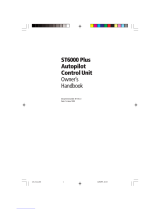
Preface iii
Contents
Chapter 1: Introduction ............................................................1
1.1 Overview ..................................................................................1
1.2 Specifications ............................................................................ 2
1.3 About this handbook .................................................................3
Important Information .............................................................. 3
Chapter 2: Using the Tiller Pilot ...............................................7
2.1 Overview ..................................................................................7
2.2 Using Auto mode ......................................................................8
Engaging the autopilot (Auto mode) ......................................... 8
Disengaging the autopilot (Standby mode) .............................. 8
Changing course .......................................................................9
Displaying navigation information pages ............................... 12
Automatic deadband control (Auto Seastate) .........................12
Operating hints – trim changes ...............................................13
2.3 Switching display illumination on and off .............................. 14
2.4 Using Track mode ...................................................................15
Selecting Track mode ............................................................. 15
Returning to Auto from Track mode .......................................17
Cross track error (XTE) .......................................................... 17
Tidal stream compensation ..................................................... 18
Waypoint arrival and advance .................................................19
Dodges in Track mode ............................................................ 19
Safety in Track mode ..............................................................20
Warning messages in Track mode ...........................................21
2.5 Using WindTrim mode ...........................................................23
Selecting WindTrim mode ...................................................... 23
Exiting WindTrim mode ......................................................... 24
Returning to the previous apparent wind angle ....................... 24
Wind shift alarm ......................................................................24
Operating hints for WindTrim mode .......................................25
Chapter 3: Maintenance & Fault Finding ..............................27
3.1 General maintenance ..............................................................27
3.2 Product support ....................................................................... 28
3.3 Fault finding ............................................................................28
Chapter 4: Installing the Tiller Pilot ......................................33
4.1 Planning the installation ..........................................................33
4.2 Installing the tiller pin and mounting socket ........................... 36
Measuring the critical dimensions ..........................................36
81130_3.book Page iii Wednesday, July 25, 2001 11:57 AM





















